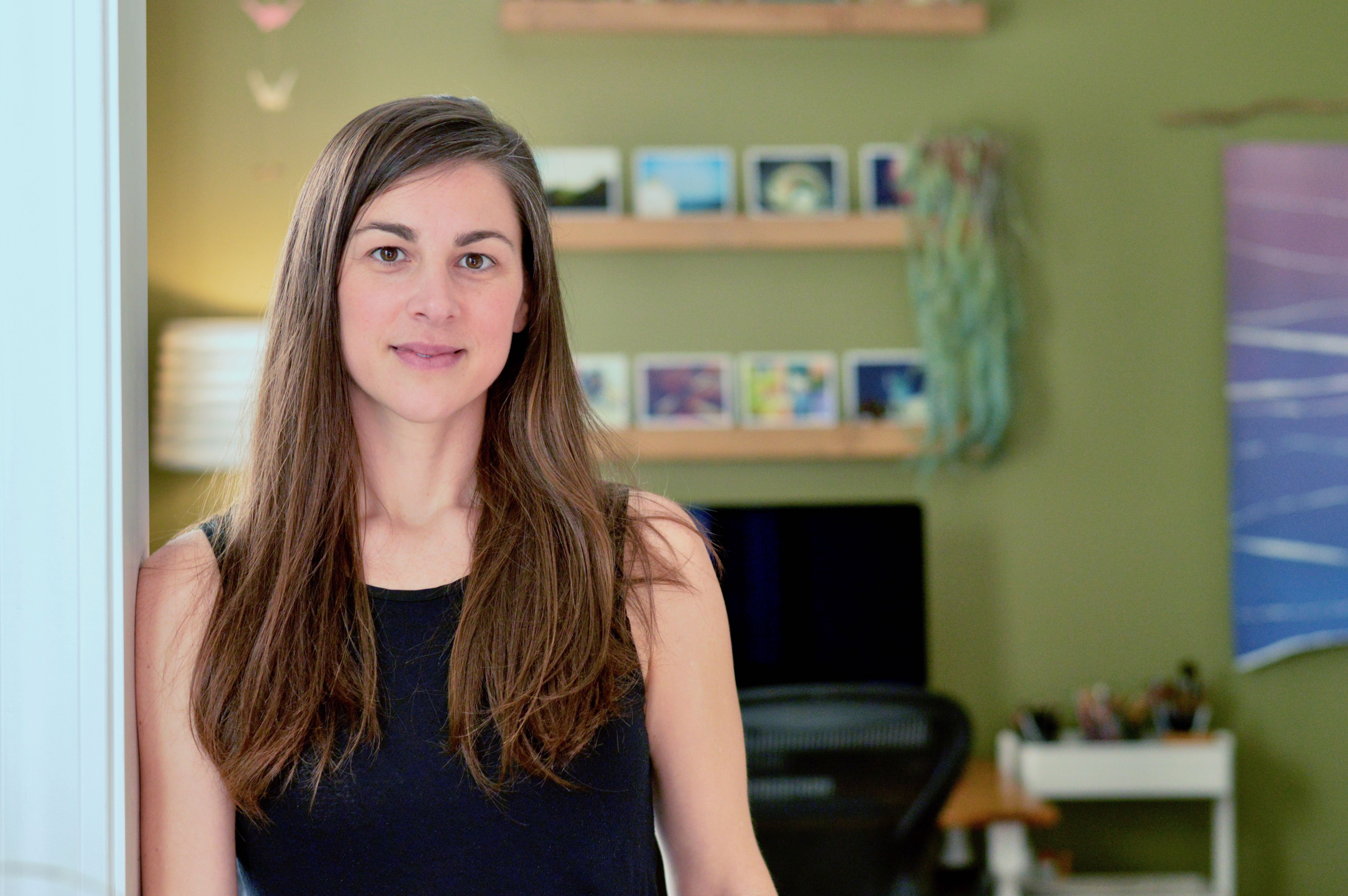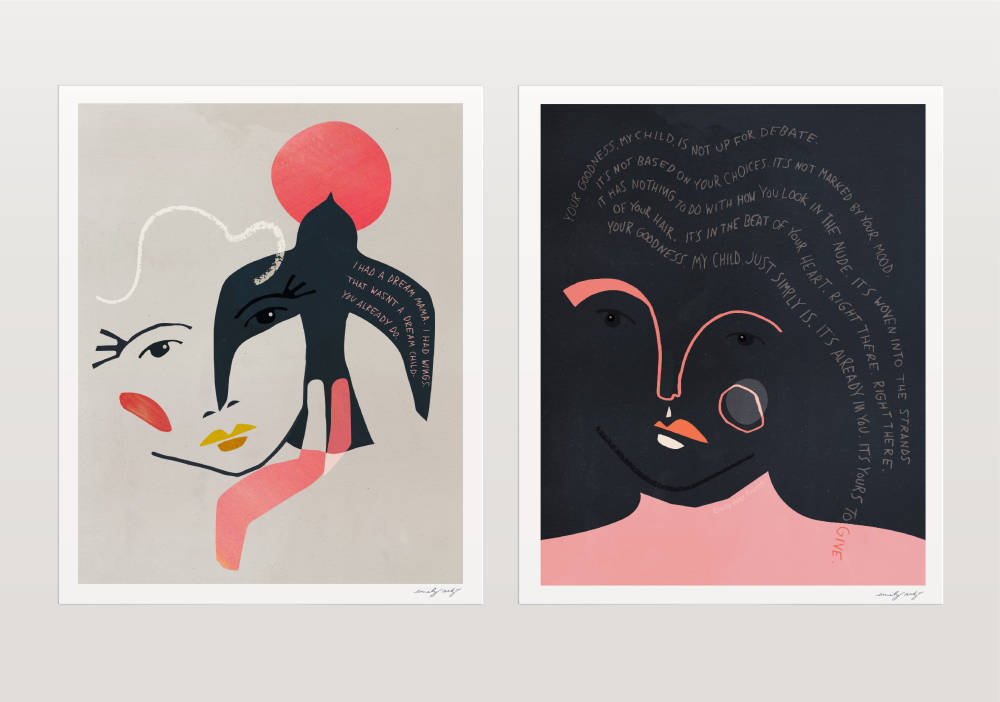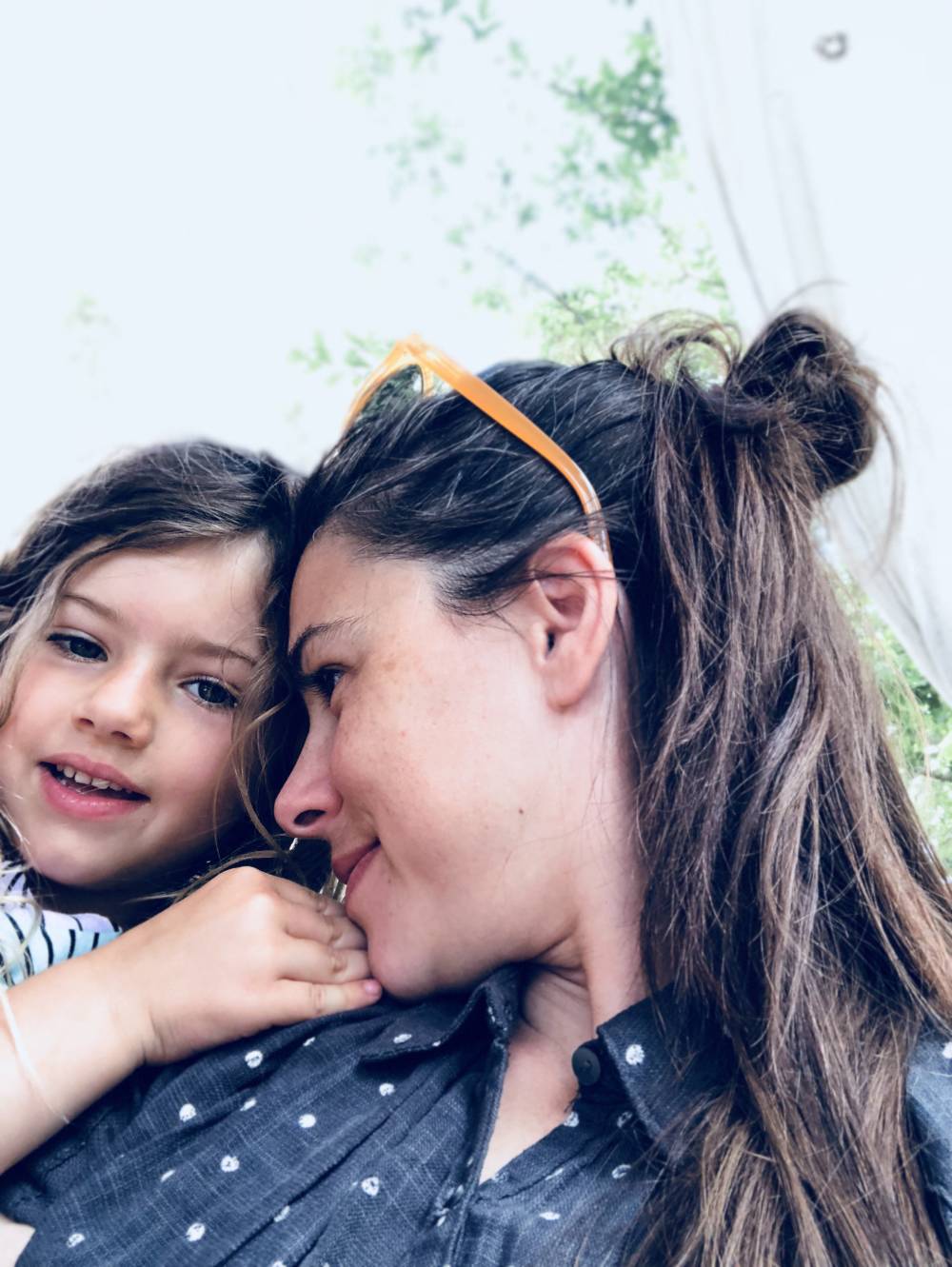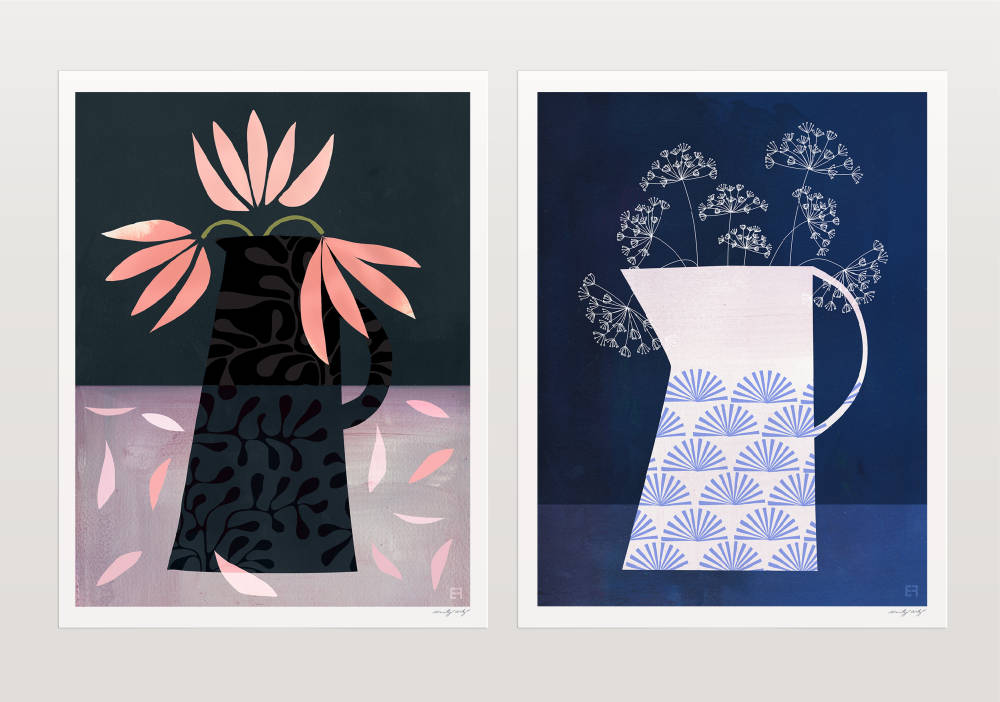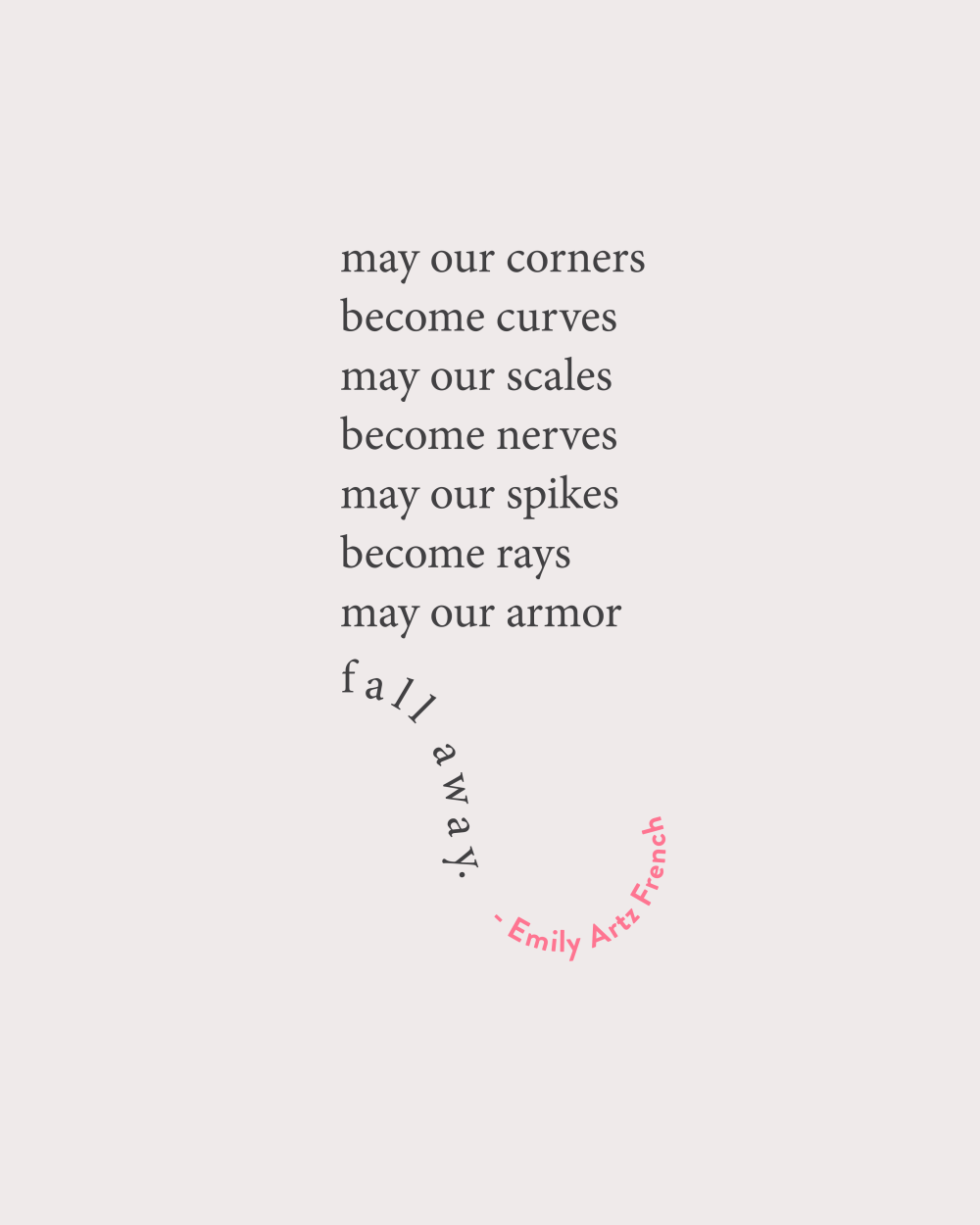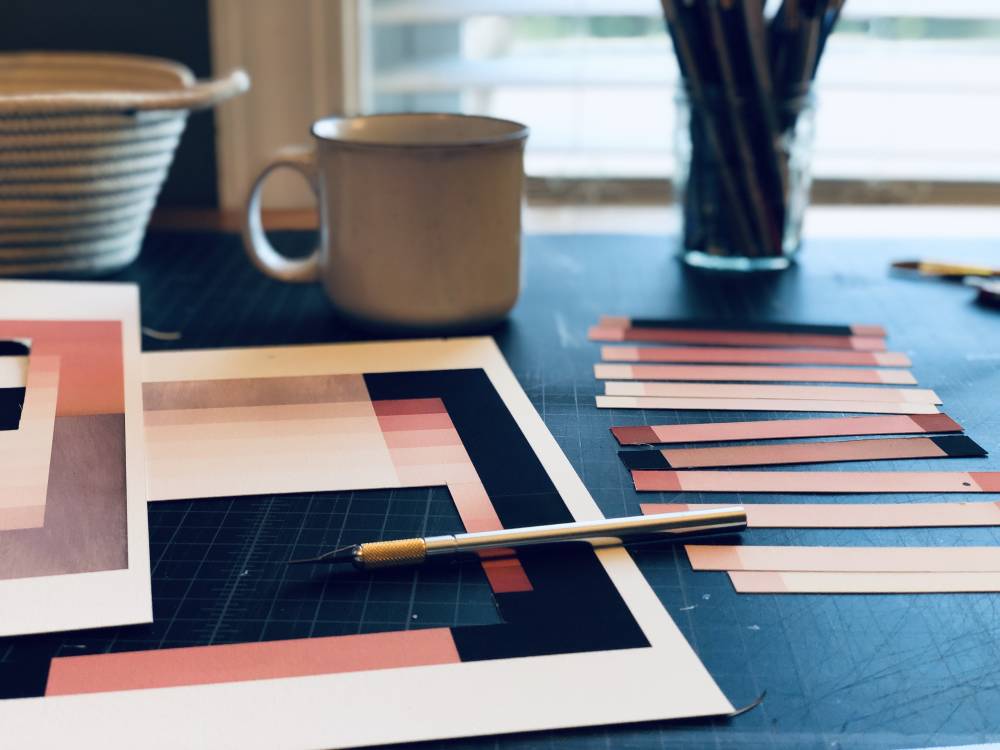Your website is so beautiful. Remind me, did you build your website yourself? Yes. I ran my own web design business for about a decade before really transitioning into art, doing more of my own personal projects. Pre-children, I was working myself to death doing that, which was great in a lot of ways, because I learned about running a business, and it allowed me to be creative in a lot of ways. But also, I was in my twenties and I had all this time on my hands, so I was a workaholic. It was a good experience in that I was able to make money as I learned. I taught myself a lot of code and mark up and that type of thing, but I joke about my website sometimes because there will be long stretches where I don’t touch it. It’s kind of like “the cobbler’s children have no shoes” type of thing, where I’m working on everybody else’s projects and they look new and sparkly and fun. I launched the one that’s up now in September or so. So, feeling pretty good about it!
You were a designer for 10 years. Let’s talk about that a little bit. Where were you living at the time? And how did you get into it? I would say my design career started in New York. I went to college at University of Virginia, and a week later I moved to New York without a job. Best decision ever. I had a place to live, at least!
I think that was 2005, so before the recession hit, and there were a lot of jobs available. Within a month, amazingly, I found a job. Not as a designer, but as an office person at a very small design agency. Because it was so small, it was one of those things where you just do what needs to be done. There were only about four to seven people at any given time in this beautiful studio space in Manhattan. It was just a really formative and special time. I learned so much about design, observing and slowly working with the design programs, and watching the art director and creative director. It was fun. I think I was one of two Americans. Everyone else was originally from somewhere else, which is also a really cool experience, getting so many different perspectives.

I was with that agency for several years until it closed after the recession hit. Creative businesses were hit the hardest. In hindsight, it was interesting to watch, because before any of the financial institutions collapsed, the creative industry was getting hit hard. After that, I decided that I didn’t want to work for anybody else, so I took a leap off the ledge and decided I was going to start working for myself. I didn’t know how I was going to pay for anything. I was living in Manhattan, so everything was expensive.
“I decided that I didn’t want to work for anybody else, so I took a leap off the ledge and decided I was going to start working for myself.”
Fortunately, I was connected to a really great group of other women entrepreneurs. We were all starting our own businesses all together at once, and a bunch of people needed design and needed websites. So what started out as working with one or two people really slowly snowballed into something that I was actually making a living doing. I have to thank those few people who put all of their trust in me when I knew absolutely nothing about what I was doing. It was just like, “We’re gonna learn this together and pay me what you can.”
I kind of failed forward doing that for a couple of years, and that’s when my husband and I got together. We then moved out of the city, but I continued to do that work with my clients in New York.
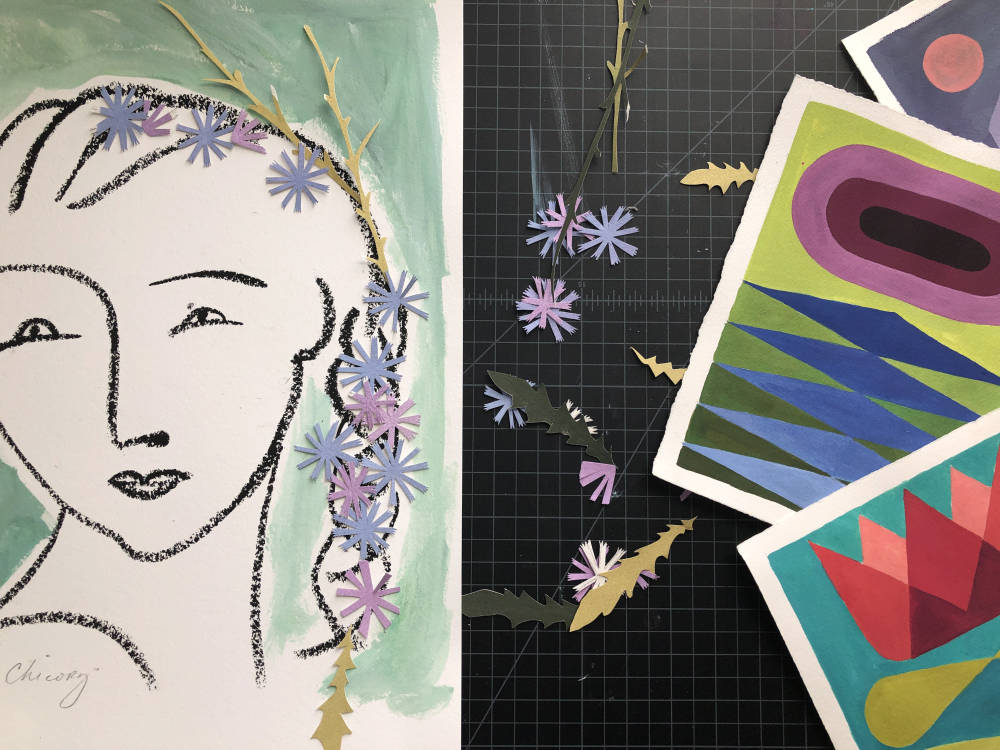
Were you an artistic kid growing up? Were the arts part of your life? Yeah. For as long as I can remember, I was super interested in art, but also words and poetry. One of my favorite books to read when I was really young was “A Light in the Attic” by Shel Silverstein. I remember lying in the hallway of my house and writing my own silly, quirky poems, and drawing ridiculous pictures with them. It’s funny, because now my daughter does the same thing, and she is a very serious artist. It’s so funny to me because I couldn’t even call myself an artist until a year ago or so. I see her coming down the same path, and it really tickles me.
My dad always admired art, and I remember him talking about how when he was growing up he took technical drawing in school, and how he wishes he would have taken art and pursued that. He was a pharmacist, very scientifically minded. But in his spare time, he was truly a craftsman. He pretty much designed and built the house that I grew up in, where my parents live now. It’s a 30 year old house, but it looks and feels like a 250 year old house, because he tore down old Civil War era houses and built the house with reclaimed materials. And even in the past five years or so, he’s picked up some oil paints and my mom and I keep encouraging him to stick with it.
It wasn’t until middle school when something kind of clicked for me in art class, when I realized, “Oh, this is something that I’m really interested in.” I got excited by the prospect that I am pretty good at drawing. I was excited about the fact that learning to draw is a skill, not a talent, and that it was a real thing that I could learn to do. Once I got into high school, I took off with it. I have to credit my high school art teacher and creative writing teacher as two of the most influential people in my life. They were huge champions of mine, and the reason for the direction that I chose for my life.
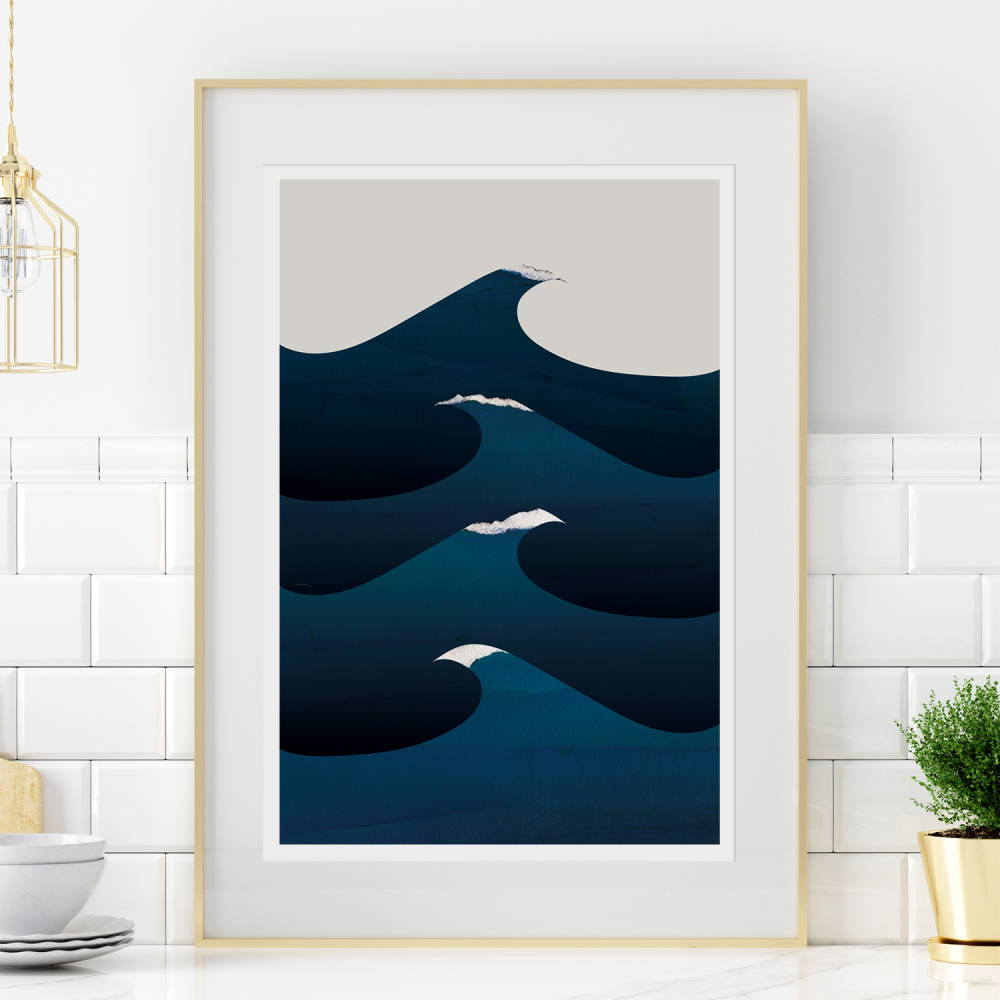
What mediums do you work in? I sometimes feel like I’m all over the place, but there is a fluidity with my work. When I’m working with physical material, I tend to use watercolor and acrylic, and I really love paper, so I tend to work with a lot of paper. I’m not as comfortable on canvas, but I want to be. It’s a goal of mine to do more work on canvas, bigger scale. I also love collage. There’s just a playfulness that I really love about it.
But because I’m so comfortable on the computer, I’ve worked in the digital realm for a long time. I love making digital work too, so my process a lot of times is to sit down and hand paint something, but then my immediate step after that is scanning it in and getting it onto my computer and manipulating and creating something new on my computer. The half life of any piece of art that I have is extremely long, because whatever I make by hand I turn into a digital piece and create a whole new collection out of it.
What I’ve realized about digital art is that you can eternally, endlessly undo a choice that you’ve made digitally. Command Z. Command Z. If you’ve done something but you don’t like it, you can immediately take it back and go in a new direction, and then you lose that uncertainty and that risk taking that is always an elemental part of making something by hand. If you choose to put a big stroke of acrylic paint down, or watercolor, that’s pretty permanent. If you don’t like it, you have to work with it and lean into that mistake, which could be thrilling, and is all part of the process and a wonderful part of it. I have to remind myself sometimes that I’m not getting that digitally. I lose something in digital art that I can only get when I’m doing something by hand.
That’s so interesting. Do you ever force yourself to just leave a mistake there? Decide not to undo? No! But maybe I need to start doing that! There was even a point where I was really getting back into hand painting and I would do something that I would regret having done. I would actually do the Command Z action with my hands in the air, because I was so used to doing it. That would be an interesting project. Like for a half hour every morning. You’ve challenged me. 2020 goal!
Let’s talk about motherhood a little bit. What was early motherhood like for you? Early motherhood was kind of dreamy for me because I was at the point of my design career that I had gotten burned out. I was really looking forward to maternity leave, and kind of told myself that I really wasn’t going to set a time limit on it, even though as first time parents we have all those fears surrounding making enough money. I had all those thoughts, but the thought of going back to work actually kind of made my stomach turn at that point. I knew that I needed to take a break. I didn’t really do anything for a solid five or six months other than just be with my daughter, and it was really nourishing and beautiful and inspiring, watching her experience the world for the first time. So magical.
“I didn’t really do anything for a solid five or six months other than just be with my daughter, and it was really nourishing and beautiful and inspiring, watching her experience the world for the first time.”
I took about six months off and when I finally decided I was ready to get back to work, I was feeling motivated to do it. I guess I’m one of those people who compulsively thinks about what I want to create next. When I started feeling that again, the most natural decision was to start my design business. I was having all these people emailing me, asking, “Are you coming back to work?” It was cheaper having a nanny come to our home, rather than put my daughter in daycare. We found a nanny, and my daughter was in our apartment with me as I worked during the day. And it was a really sweet six months of that. It just worked for us at the time. I mean, financially, who knows if it worked, but I was working and it felt good to work, but also have her with me.
I think about that, too. In the beginning, I was totally thinking in financial terms all the time. Like, I can’t possibly get started with my work because I won’t make any money, and we won’t be able to afford childcare. And then after a time, you realize that you have to honor that part of yourself, so you’ll find the money. I realize that’s a privileged thing to say, but when you find the money to deal with the childcare, you find that your mind is freed up a little bit, and that mental health is worth everything. Now, we live in a country where childcare is expensive and not free for anybody, so I’m sure it’s different in other places of the world, but I think about that often. When I had my son, everything was financial in my mind. I can’t go practice because I won’t make any money if I have to hire a babysitter. But you need it. You need it. You absolutely need it. The financial part is such a head game. And you’re right. It’s a privileged thing to be able to say, “I’m going to go make art”. It was something that I struggled with up until just recently. I always felt like, no, I need to contribute to our family’s income equally. I’m capable. I have the skills to do it. Twenty-first century woman, right?
But even when I was running my own business, there was a longing that I felt wasn’t being fulfilled by client work, and it was constantly nagging at me. I knew it was because I wasn’t pursuing the things that I wanted to be pursuing. I didn’t even know what that was because I hadn’t given it any attention for years. Also, there was a fear attached to it. What if I start pursuing my art and there’s nothing there? What if I’m not inspired to do anything, or I don’t even know how to make art anymore? I had all these excuses as to why I never really allowed myself that time, even if it was one day a week. Monday through Thursday, work with clients. And on Friday, I’m closed. It was physically impossible for me to do it.
“In hindsight what I realized is, I’m helping my husband pursue his dream, and that’s really fulfilling. But why haven’t I ever been okay with allowing myself to do what I’m letting my husband do?”
A lot of it was tied up with fear around money. It wasn’t until the past couple years when that changed. My husband and I went down a path of launching a technical startup. It meant my husband quitting his job and both of us working on this project. We were living off savings 100 percent, paying lots of money to get this up and running. It was maybe two years of that really intense uncertainty. It was a really amazing journey, actually, in a lot of ways. But in hindsight, what I realized is, I’m helping my husband pursue his dream, and that’s really fulfilling. But why haven’t I ever been okay with allowing myself to do what I’m letting my husband do? We are stopping work because we have the savings to pursue this huge endeavor, and I haven’t even allowed myself the fraction of time or money to do what I know I want to be doing. It was this light bulb for me.
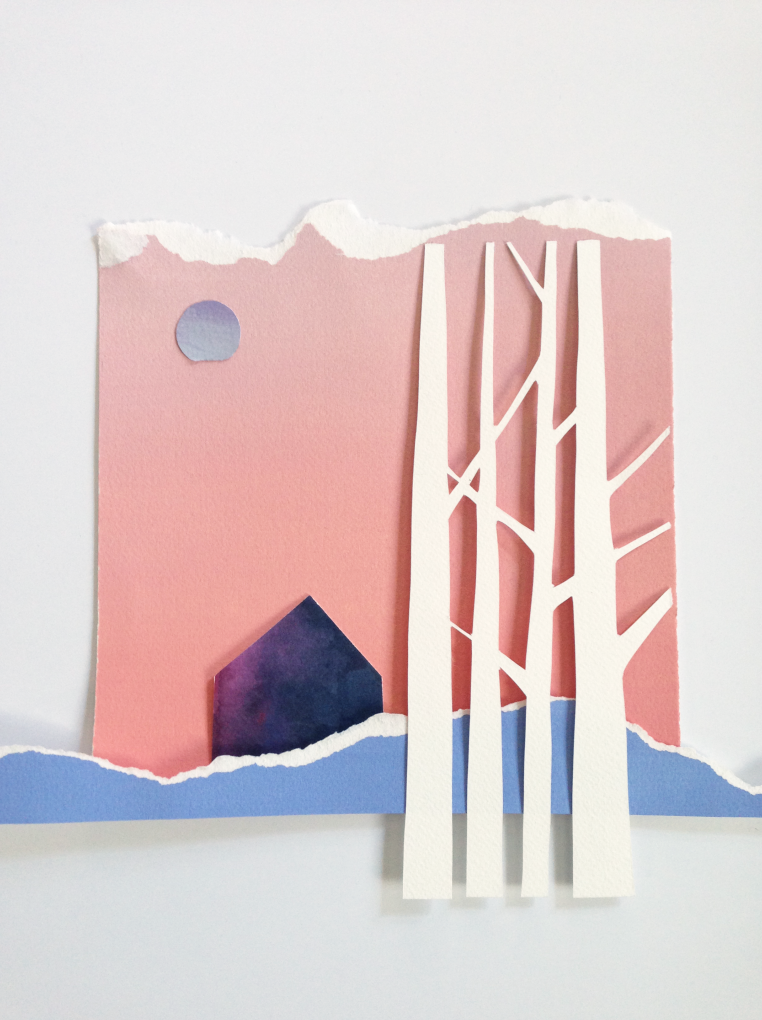
Eventually it became clear that we were ready to shelf the startup. We just didn’t have the resources to do it. That was when I finally gave myself the green light to say, “Okay, now I’m doing it,” for whatever reason, “I’m now giving myself permission to pursue it.”
I went through this period of just being home with my kids when they were very, very young. I started getting really motivated to do more artwork and moving away from client work. And then we started the startup, and then I felt so conflicted all the time because I wanted to be making art. It’s been this push and pull between knowing what I really want to do, and now finally, being honest with myself. So finally, at 37, I am going for it.
“So finally, at 37, I am going for it.”
One thing that we had talked about the first time we did this interview was how you went through a dark period when you were living in New York. Absolutely. That period of my life started when I was in high school and persisted until I was an adult living in New York. I was a student athlete growing up. When I wasn’t doing schoolwork, I was playing sports or working at my dad’s pharmacy. I tore my ACL playing basketball, which was a devastating injury and I had to have surgery. It turned my life upside down, because prior to that I was spending so much time with my teammates and I had always had a purpose. I was busy. I was suddenly thrust into having a lot of alone time and going through puberty at the same time. My body was changing. I was internalizing everything, questioning a lot. That was the catalyst for depression and an eating disorder. For most of my junior and senior year of high school, I was in the throes of a really serious eating disorder and depression. Not really sure which was worse.
I struggled during my entire college career with that, and that’s a little bit sad because memories of college for me weren’t great. I was really just trying to get well. I wasn’t having a really great college career. My most formative years as a young adult were when I was living in New York. At that point I was on my way to recovery, even though a lot of the behaviors of eating disorders take years to recover from. In college, I admitted myself to an inpatient program for the eating disorder, and that is when I had an epiphany about my life. Prior to that, I was depending on my doctors to help me get well, and it took me holing myself up to realize no, it’s actually up to me to get well. It was after that experience that I had an “aha” moment. I left there feeling very different about things. That’s not to say that I didn’t struggle for many years after that, but it wasn’t a question in my mind anymore, whether or not I was going to get well. I knew I was, because I felt I had taken on the responsibility of it, rather than hoping that other people would help me or fix me.
Unfortunately, the nature of an eating disorder is a lot of lying and hiding and shame, and you could be lying to the people closest to you, and they would have no idea. So there was still plenty of that. I actually have to credit my husband. When I made the decision, my husband and I were roommates for a year and a half before we became more than that. That was when I ultimately decided, Yes, I’m good. I’m going to do this. I’m going to go into this relationship and finally, all of my past behaviors, self-destructive behaviors, I completely stopped.
I wasn’t making any art during that period of my life. I majored in art, and I was in New York, where you go to pursue your creative career, but I wasn’t making my own art. I was working on getting well, and that’s what that was really important.
You can’t make your art unless you’re well, right? I remember having a conversation with someone while I was in New York, a fashion designer friend, and I was having a conversation about my struggles, and how I felt so happy now that I had made this recovery. And he said something like, “Well, don’t you need all that rage to make art or something?” And I was thinking, Oh, maybe? Am I ever going to be able to make art again? Because I’m not so full of emotions?
“There is so much inspiration as a mother. It’s a well that never ends.”
I don’t know. I mean, I suppose there’s this vision of the tortured artist soul, right? Maybe I shouldn’t go here, but I think that that applies to the non-parent or something. In order to parent and care for others, you have to be well. So maybe this is a different type of artist that we are, in this day and age. As mother artists, it’s about making art from a place of mental health. Yes, yes. There is so much inspiration as a mother. It’s a well that never ends. I also remember distinctly having a thought before I had my daughter. I might have been pregnant, I can’t remember. Maybe we’re trying to have children. I was having this mental conversation with myself about pursuing art. I didn’t know why I hadn’t allowed myself to do it, and I was having this really strong sensation that I needed to have children in order to do it, and not really knowing where that sensation came from. It was a certainty. This is what we have to do!
I don’t really know where that came from. Maybe it was a self-fulfilling prophecy, or a precognition. But for whatever reason, I lacked inspiration before, or I allowed my fears to get the best of me. And I needed to let myself go into such a big, uncertain thing, parenthood, to see what was on the other side.
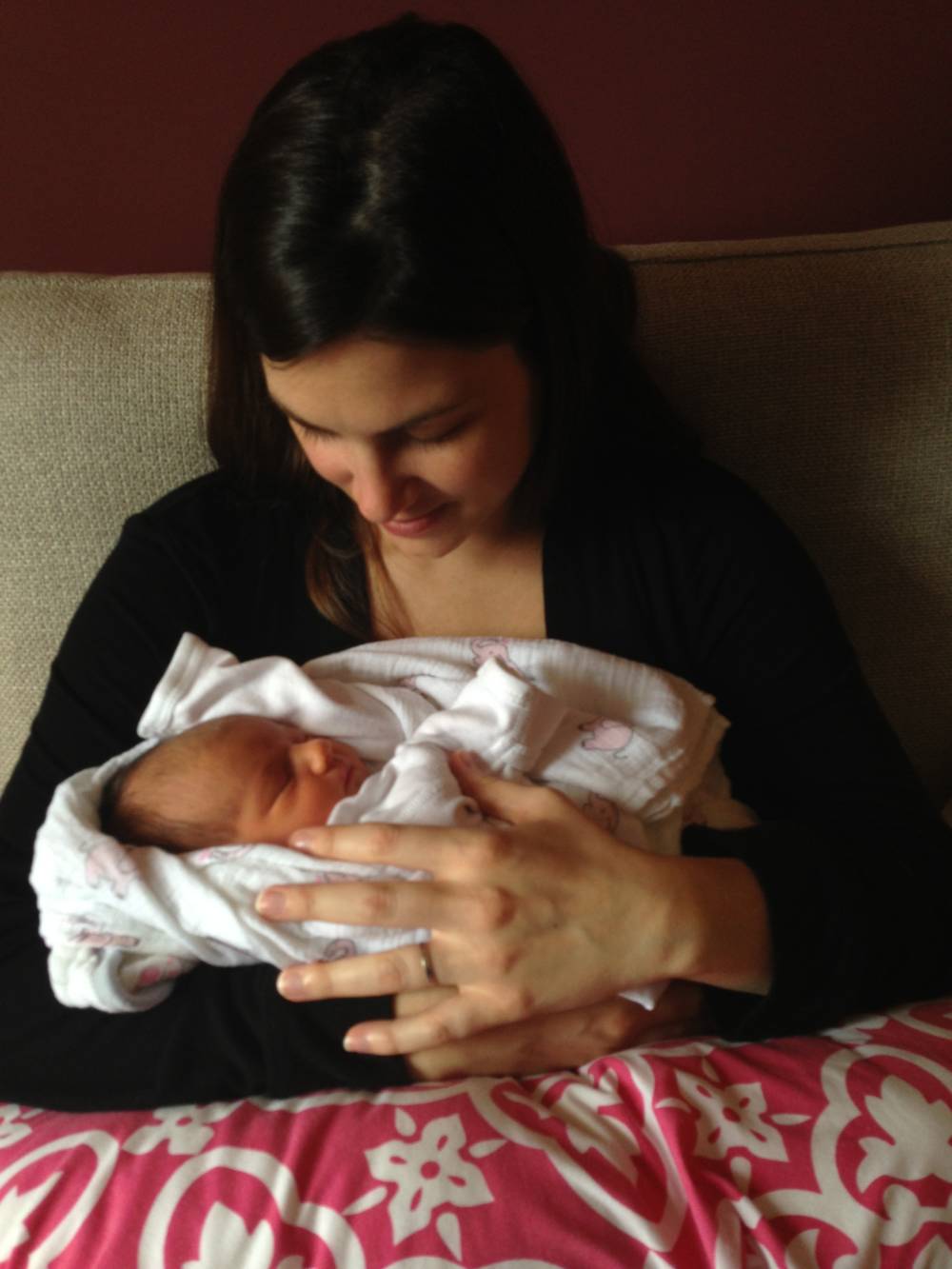
Can you give an example of some way that motherhood has inspired your work? I will admit that after I had my daughter, I felt like I had to jump back into it, to an extent. And I do feel like even though I took a long maternity leave, there was something about motherhood that left a little frustration there. “She’s so dependent on me. I just want to get back to work. I just need to have more time for myself.” I was using so much mental energy with that frustration, rushing her. It was when I had my son that I realized how small my daughter still was, and that I really just needed to slow down and soak up their smallness, because I was wasting so much energy wishing they weren’t dependent on me.
When I realized, “Oh, they’re both still really small, and this is a really magical time. They’re not going to be small for long,” it freed up space in my head to start paying attention. It’s the magic of someone experiencing the world for the first time. Everything was new to them. And when I really stopped to think about that, that’s when I took my daughter out of daycare and I started being home with them. That’s when things just started exploding for me. They would come into my office and I would make art while they played around my feet. There wasn’t ever a structure. They never napped at the same time, and I never had a period where I could go make art. I just want them to see me doing the thing that I love to do. The wonder that they experience is a constant source of inspiration for me.
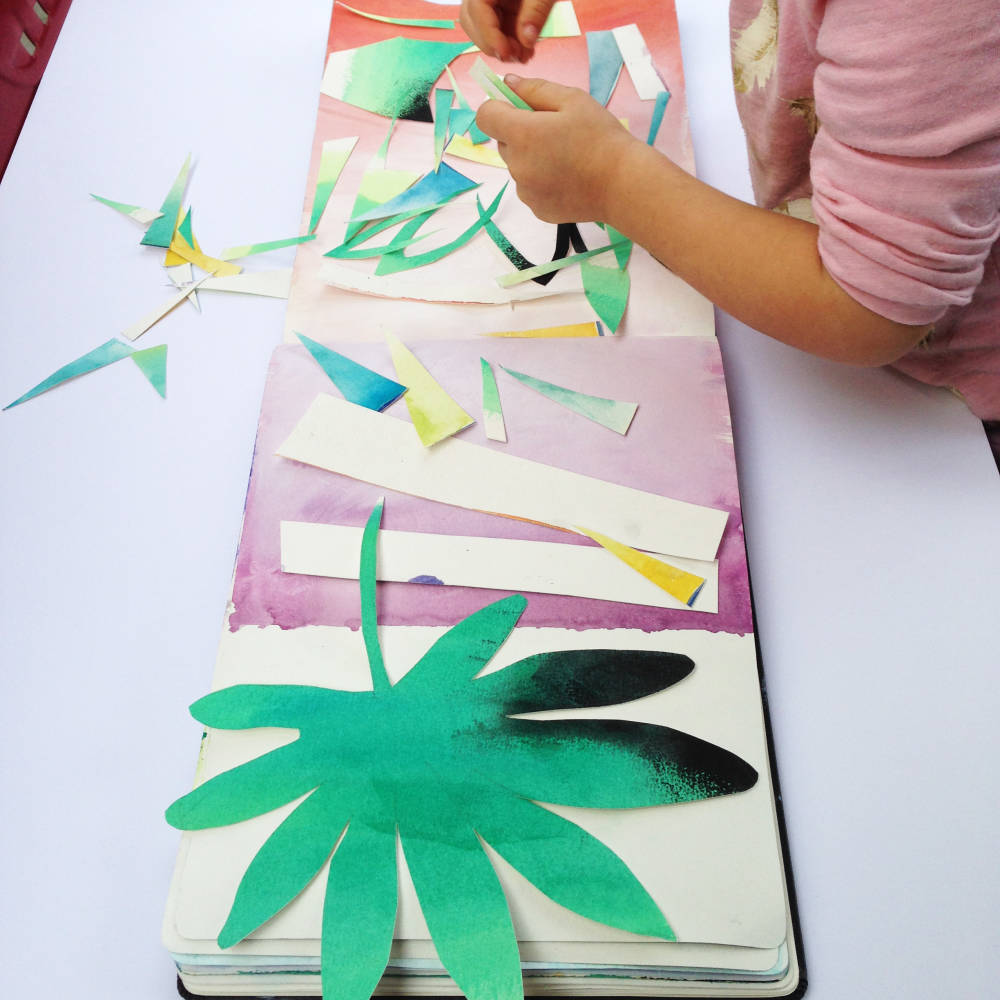
What a huge shift. I feel like I’m in that space right now. The space of: I just want to be alone, for God’s sake. And then, like you say, this time is so short and you know it’s going to be over like that. Maybe there’s another mental space that I couldn’t get myself to, which is, why not just involve them? Yes, I have to catch myself sometimes. If I’m working on a project and my son or daughter wants to be in the office with me, they want to see what I’m doing, and they want to put their hands on things, and I want to say, “Don’t touch that!” and then I bite my tongue because I don’t want their experience of me making art to be exclusive. So don’t get me wrong. There have been many times where I didn’t say the right thing, because I was working on something that I didn’t want them to touch, but I’ve always wanted it to be an inclusive experience, because that’s what art is, right?
I think it’s really powerful to let your children see you do the thing that you love to do, but more than that, to let them see you struggle doing the thing you love to do and persist anyway. Because that’s a natural part of it. I think our society has this idea that if you’re doing the thing you love to do your life is going to be easy, but it’s not. That’s a really powerful thing to show your children—that you do it anyway because you love it, and because it is hard.
“I think it’s really powerful to let your children see you do the thing that you love to do, but more than that, to let them see you struggle doing the thing you love to do and persist anyway.”
What are you looking forward to in your work and in your family? I have some 2020 goals, I’m going to admit. I don’t know if I would call them resolutions, but I have a lot of children’s book ideas in my head. The writing comes easily for me. It’s the illustrating, weirdly, that I struggle with, because that there’s just so much planning involved in it. I have a really hard time focusing on one idea. I feel like I’m all over the place, going in ten directions at once. Finding the discipline to see one project through is going to be a theme for me this year. I hope that a children’s book comes out of it.
For my family, just spending as much time together as we can. Don’t get me wrong, I love my alone time, and I have about six hours of it a day, and that’s vital for me and my mental health. I’m happy that my kids are at the age now that they go to school, and they have really rich school environments. They’re both in Montessori school, and my husband and I are so grateful for that. It’s such a wonderful curriculum, and the growth that I see in my children at home is just amazing. But quality time is my number one love language. Quality time with the people that I love is just it for me.
“Things will happen when they are supposed to happen.”
What advice do you have for other Mother Makers? Don’t be so hard on yourself. Things will happen when they are supposed to happen. That is so cliche, I know, but there have been so many times in my life where I wished that something was happening for me and it didn’t happen. And years later, when it actually comes to fruition, I think back about the time that I wished that it was happening and I’m so grateful that it didn’t happen then because I wasn’t ready for it. That seems to be a constant theme in my life, that I want to control the timing of things, and we have so little control over that. Time and time again, it proves to me that it’s a good thing that I’m not in control of it because it happens when you’re ready for it.

